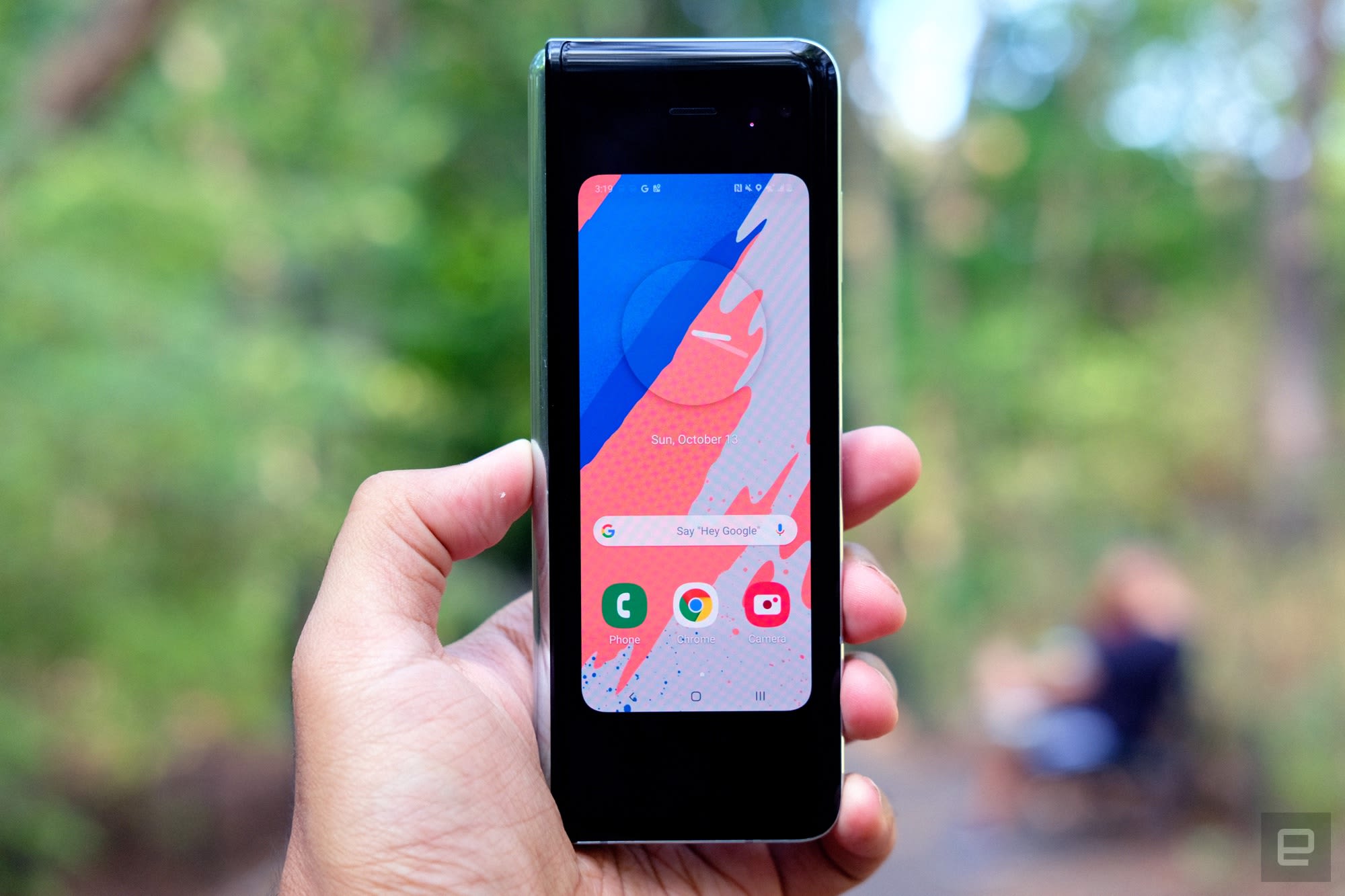Sponsored Links
![]()
The Galaxy Fold lives.
I don’t just mean in the vague “Samsung bounces back from a fiasco” sense, either. My Galaxy Fold, which I’ve been tossing around for weeks, opening and closing it like a madman, mostly works the same as it did the day I unboxed it.
Had the Fold failed again the way it did earlier this year, it might have been enough to seriously derail Samsung’s grand, foldable ambitions. This review would’ve been totally different, too. I could’ve gotten on my high horse and said a few things about innovation at the expense of usability, with a dash of pro-consumer indignation to spice things up a bit. It would’ve been a fun read.
But reality can be pretty banal sometimes. Because of that, we instead have to face a more complicated truth about the Galaxy Fold: You shouldn’t buy one. Not because it’s expensive, or because of its long-term potential for failure, although those are valid concerns. No, you shouldn’t buy one because it’s just not quite as thoroughly thought-out as a $2,000 phone should be. When I wrote our original review, I said that people who did splurge on one were paying for the privilege of being Samsung’s guinea pig. Despite the company’s thoughtful design fixes, that simply hasn’t changed.
- Game-changing flexibility
- Excellent performance
- Solid battery life
- Seriously expensive
- Outer screen is of limited use
- The inner screen’s durability is concerning
- The software feels unpolished
Samsung’s Galaxy Fold is one of those devices that inspires adoration and annoyance at the same time. Its foldable design means you can carry around a tablet in your pocket and get plenty of work done along the way. The Fold’s power and flexibility nothing short of intoxicating, but as a commercial product, it leaves much to be desired. While closed, it’s chunky and clumsy, and we have serious concerns about how well its main screen will hold up over time — our review unit’s display developed dead and stuck pixels out of the blue, and we’ve seen a few other units with more pronounced blemishes. The Galaxy Fold offers a glimpse at the future of smartphones and gives Samsung a potent foundation to build on, but almost no one should consider buying one right now.
How would you rate the Galaxy Fold?
We want to hear what you think. Post a quick review now to join the conversation!
Write a review
Author’s note: Our original Galaxy Fold review provides a more comprehensive look at what Samsung’s first foldable phone has to offer, with a focus on its software and overall usability. Not much has changed there, so be sure to read that too to get the full picture. For the purposes of this piece, I’ll be focusing primarily on the phone’s durability — the reason it was delayed and retooled in the first place.
Before we go any further, let’s just establish that the Galaxy Fold gets nearly all of the standard smartphone stuff right. Its three main cameras take fantastic photos, and framing them up on the small, external display is surprisingly useful. Its dual-battery system means the Fold will last for well over a day on a charge. I even enjoy taking calls while the Fold is closed — it feels like using a phone from 2005 in a way that I find immensely satisfying.
Of course, the Galaxy Fold is anything but standard.
During my first go-around with the Fold, I said I found the functionality it offered intoxicating, and that’s still true. The 4.6-inch external AMOLED screen is best suited to quick interactions, like glancing at your notifications. Even so, I can’t tell you the number of times I’ve started thumbing through an email on the subway and opened the phone to bash out a quick response. Or when I’ve been reading a Kindle book on the main 7.3-inch display and closed the phone so I could take up less space for the person sitting next to me… also on the subway. (What can I say? I spend a lot of time on trains.)
Once you get used to starting a task on one screen and whipping the Fold open to complete it on another, you’ll probably be hooked. Ditto for when you’ve loaded up three much-needed apps to run on that spacious screen at the same time, allowing you to furiously multitask. When you master the Fold’s nuances, Samsung’s approach starts to feel tremendously valuable. But that’s not to say the Fold experience is perfect.
While I believe Samsung got the overarching experience right, the Fold’s software needs some finesse. To their credit, Samsung says it went back to make some changes after the review unit debacle, though the few updates I noticed seemed minor.

Unfortunately, some issues persist. Some apps don’t lend themselves well to being stuffed into a multi-window grid, and the only way to find out is through trial and error. Trying to re-open your carefully curated app grids still feels like a crapshoot — sometimes you can bring them back with a swipe on your homescreen, other times you can’t. And some apps, like Instagram, continue to display incorrectly on the main screen; you have to close the phone to view it the way it was meant to be seen.
Of course, the beauty of software is that it’s mutable, subject to change over time. Over the coming months, developers inside and outside Samsung will likely retool at least some of their software to work more elegantly on devices like the Fold. It doesn’t hurt that Samsung has set up validation labs in cities from Mountain View to Beijing to help developers ensure app compatibility with the Fold and that some of Samsung’s early multi-screen work influenced some of Google’s decisions when crafting Android 10.
So yes, even after Samsung went back to the drawing board, the Fold still has plenty of quirks. But when it comes to getting things done, the Fold still feels like it has the ability to offer the right amount of phone at the right time. It’s useful, if rough around the edges.
Thankfully, the physical improvements Samsung made to the Galaxy Fold serve to fix the concerning design faults I spotted the first time. The version of the Fold that almost went on sale earlier this year had noticeable gaps at the top and bottom of the main display, where dirt and debris could feasibly shimmy inside. The hinge felt a little too weak, especially when it came to locking the two halves of the Fold in place while open. The screen felt surprisingly spongy, which just isn’t what you’d want out of a $2,000 phone.

All of those issues were addressed, and surprisingly well, to boot. Those pesky gaps have been plugged up with plastic stoppers and what appear to be small strips of adhesive. The phone is still easy to open, even with one hand, but the Fold’s halves lock into place much more securely. And that screen? It’s been bolstered with some extra material that prevents the soft plastic panel from flexing downward too much. More importantly, the protective plastic layer on top of that screen doesn’t look like a flimsy screen protector anymore — it stretches underneath the screen’s raised bezels, removing all temptation to peel it off.
Because Samsung hasn’t discovered time travel yet, it couldn’t go back and re-engineer the Galaxy Fold and fix certain other fundamental issues. That big, beautiful screen is still prone to jelly scrolling, where content on one side of the display moves slightly faster than the other. And you’re just going to have to get used to that crease because it’s not going anywhere. These aren’t great characteristics for a phone this expensive to exhibit, but I wouldn’t say they’re dealbreakers.
In any case, I went out of my way to open and close my Fold more than I ever needed to — in a way, it became a ludicrously expensive fidget toy. And on the occasions when the Fold accidentally clattered to the ground, it didn’t seem any worse for the wear. Because of these improvements, this version of the Fold doesn’t feel quite as slapdash as the original, and in my experience so far, it’s not quite as flimsy as some of the prevailing chatter would have you believe.
But again, that’s only for now. Living with a phone for three weeks still isn’t enough time to say for sure how it’ll hold up in the long term, especially when it’s objectively more fragile than other smartphones. Even though I stopped worrying about the Fold suddenly dying on me, that low-key fear didn’t exactly disappear. Now I wonder what will eventually do it in, because something surely will. A careless drop onto asphalt while the screen is open? Maybe. Will some pocket lint somehow squeeze in where it wasn’t supposed to? I can’t rule that out either. Sometimes, things just happen. And well after I had I drawn some conclusions about the Fold, something did.
Last week, I popped out for an after-work drink with a few friends. Since the Fold is nothing if not a conversation-starter, one of them asked to see the device for themselves. A few oohs and aahs later, she handed the Fold back to me and asked “what those green spots were.”

Lo and behold, a few pixels near the top of the big screen had either died entirely or gotten “stuck” displaying green instead of whatever color the software actually called for. I tried a few apps that try to fix such faults by rapidly changing colors on the screen in hopes of “unsticking” those pixels, but no such luck. (Ironically, since these apps weren’t optimized for the Fold, they couldn’t even access a segment of the screen next to the notch where one dead pixel lived.)
To be clear, the screen was working perfectly normally that morning, and my friend didn’t drop it before handing the Fold back to me. Maybe this had something to do with all my nervous folding and unfolding. Maybe an earlier fall dislodged something inside the phone. There’s no way to know for sure. In fairness, these stuck pixels in no way impact how the Fold functions, and over time, I could maybe see myself learning to ignore them — they’re just a couple tiny spots, after all. Still, I can’t help but expect more from a phone as ambitious and expensive as this, especially since I haven’t found stuck or dead pixels on any other device I’ve tested in recent memory.
Since Samsung offers what it calls “premier” service to Galaxy Fold owners, I thought I’d try ringing up one of the company’s concierges for a quick video chat to walk through my options. That all happens through the Samsung Members app, which states that staffers (in the US at least) will be on hand between 9AM and 10PM Eastern between Mondays and Fridays for that express purpose. After waiting nearly 40 minutes for a representative with no indication of whether anyone was coming, I just called Samsung over the phone instead.
The call was connected immediately, and the Samsung rep quickly told me that the fastest way to get the Fold fixed would be to go to Samsung’s 837 digital playground/event space, which apparently doubles as a repair center. Fair enough! After a confusing back and forth and a handful of extended holds, the rep ultimately confirmed that these dead pixels were likely to be a manufacturer’s issue, and the phone would be fixed free of charge. Had I actually damaged that internal screen, it would’ve cost me $150. And if I had damaged it again, the second, out-of-warranty repair would cost me $600.
“Yeah, it’s rough,” the rep said about that pricey second repair.

I’m not the only person to run into issues with these updated models, even if they’re not as severe as what we saw back in April. Our colleague at TechCrunch, Brian Heater, randomly noticed a cluster of busted pixels on his Galaxy Fold. Even now, he’s not sure what happened. Meanwhile, our own Richard Lai spotted similar damage on a Galaxy Fold in Hong Kong — a shop owner told him the damage might have happened because the user pressed down on the center of the screen to un-latch and close the phone. And for what it’s worth, CNET live-streamed a Galaxy Fold stress test that showed the phone’s screen failing at around 120,000 folds, well short of Samsung’s 200,000 fold projection. That last one doesn’t accurately reflect real-world use since it realistically equates to a few years of worth of folds happening in a day or two, but it’s still not a great look for Samsung.
NOOOOOOOOOOOOOOOOOO pic.twitter.com/V90TCG7Ivx
— Richard Lai (@richardlai) October 11, 2019
These issues don’t seem particularly widespread but to me, they suggest Samsung’s fixes here aren’t a panacea for all of the Fold’s ails. iFixit’s thorough teardown backs up my hunch: Their team found the phone to be “alarmingly fragile.” Because of that, the Galaxy Fold’s mortality is never far from my mind.
Beyond that, the Galaxy Fold’s design comes with other constraints. Consider this: A Samsung spokesperson once offhandedly remarked to me that the Fold isn’t the kind of phone its owner would take to the beach, which made zero sense to me. What else would they bring, if not their new phone? Are these people expected to have backup phones for day trips like that? And that scenario quickly led to many others in any head: The Fold doesn’t promise any water resistance, so should I chance it running through a rainstorm? Do I have to clean out my backpack before slipping the phone inside? And most important, what good is a phone that can’t go where you do?
These are the kinds of questions that linger in the back of my mind while I’m using the phone to finish a crossword or mark off tasks in Notion. I’m not sure they’re ever going to vanish. And really, that’s where all my hesitance about the Fold comes from.

Yes, that foldable screen makes this Galaxy more flexible, more capable than any other device I’ve tested recently. But that flexibility is only a benefit if you decide you can live with the Fold’s various limitations. You might be able to get away with tossing it around like you would any other device. Still, babying the Fold is probably the best way to go, and that’s just not always reasonable.
I don’t mean to detract from the level of engineering skill that went into designing the Fold. Even with its faults, the Galaxy Fold is a stunning technical achievement, one that on some level has spoiled all other smartphones for me. For the most part, I love what this phone can do. But it comes with too many caveats to warrant that nearly $2,000 asking price.
I will eventually have to give this review unit back to Samsung, so I get to dodge the inevitable what-ifs. If I didn’t, though, I’d probably spend the rest of my time with the phone resigned to the fact that, at some point, I would screw it up. That’s just what happens when your first taste of the future is an inherently fragile one.
Instead, I choose to celebrate the Galaxy Fold for what it really is: one of the industry’s most ostentatious tech demos, and a first step toward hardier, more capable foldables down the road. Most of you shouldn’t even think about buying this phone. But the next one? The one that benefits from all the valuable hard knocks Samsung took for this model? Well, here’s hoping.
All products recommended by Engadget are selected by our editorial team, independent of our parent company. Some of our stories include affiliate links. If you buy something through one of these links, we may earn an affiliate commission.

Comments

103
Shares













